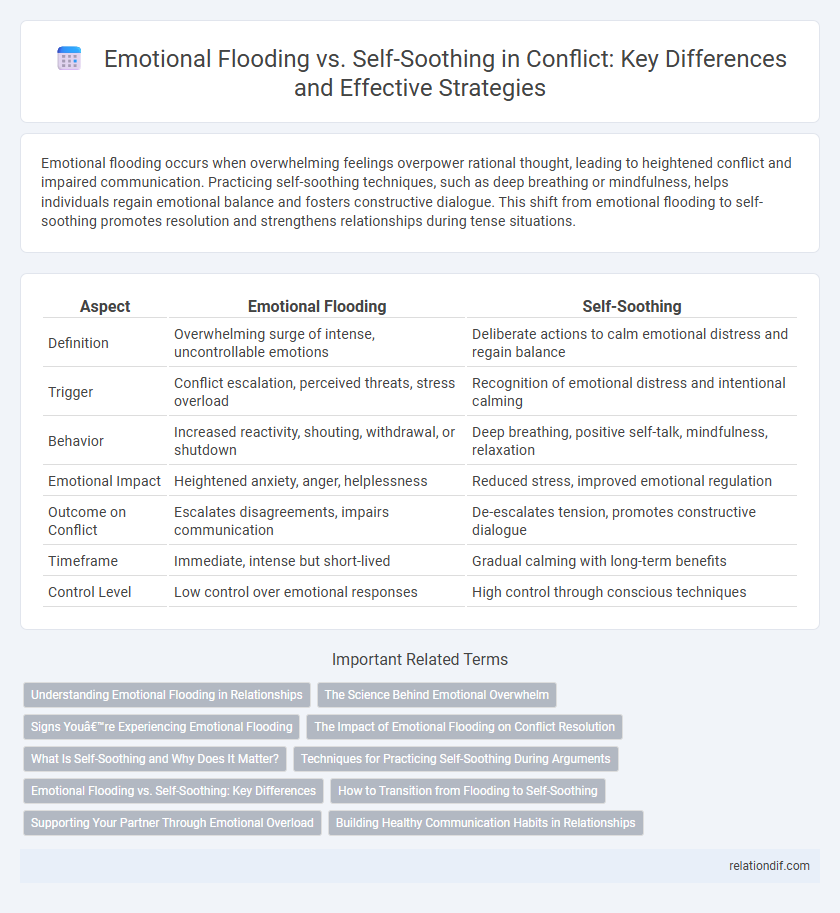Emotional flooding occurs when overwhelming feelings overpower rational thought, leading to heightened conflict and impaired communication. Practicing self-soothing techniques, such as deep breathing or mindfulness, helps individuals regain emotional balance and fosters constructive dialogue. This shift from emotional flooding to self-soothing promotes resolution and strengthens relationships during tense situations.
Table of Comparison
| Aspect | Emotional Flooding | Self-Soothing |
|---|---|---|
| Definition | Overwhelming surge of intense, uncontrollable emotions | Deliberate actions to calm emotional distress and regain balance |
| Trigger | Conflict escalation, perceived threats, stress overload | Recognition of emotional distress and intentional calming |
| Behavior | Increased reactivity, shouting, withdrawal, or shutdown | Deep breathing, positive self-talk, mindfulness, relaxation |
| Emotional Impact | Heightened anxiety, anger, helplessness | Reduced stress, improved emotional regulation |
| Outcome on Conflict | Escalates disagreements, impairs communication | De-escalates tension, promotes constructive dialogue |
| Timeframe | Immediate, intense but short-lived | Gradual calming with long-term benefits |
| Control Level | Low control over emotional responses | High control through conscious techniques |
Understanding Emotional Flooding in Relationships
Emotional flooding occurs when intense feelings overwhelm an individual, impairing rational thinking and escalating conflict in relationships. Recognizing early signs such as rapid heartbeat, heavy breathing, and irritability helps prevent emotional hijacking that damages communication. Practicing self-soothing techniques like deep breathing, mindfulness, and taking a timeout reduces emotional flooding, fostering healthier and more constructive interactions.
The Science Behind Emotional Overwhelm
Emotional flooding occurs when the brain's amygdala triggers an intense stress response, overwhelming the prefrontal cortex responsible for rational thinking, which impairs conflict resolution. Self-soothing activates the parasympathetic nervous system, reducing cortisol levels and promoting emotional regulation by calming neural pathways associated with stress. Research in neuroscience highlights that deliberate self-soothing techniques enhance resilience and cognitive control, preventing emotional flooding during interpersonal conflicts.
Signs You’re Experiencing Emotional Flooding
Rapid heart rate, shallow breathing, and overwhelming feelings of anxiety signal you're experiencing emotional flooding during conflict. Difficulty thinking clearly, intense irritability, and physical tension such as clenched fists or tight muscles further indicate emotional overwhelm. Recognizing these signs early allows for effective self-soothing techniques to regain calm and prevent escalation.
The Impact of Emotional Flooding on Conflict Resolution
Emotional flooding during conflict triggers intense physiological arousal that impairs rational thinking and effective communication, often escalating disputes rather than resolving them. This overwhelming state activates the amygdala, resulting in heightened anger, anxiety, and defensiveness, which obstructs problem-solving abilities. Employing self-soothing techniques, such as deep breathing and mindfulness, helps regulate emotional responses, promoting calmness and facilitating constructive dialogue essential for conflict resolution.
What Is Self-Soothing and Why Does It Matter?
Self-soothing involves calming oneself during emotional distress using techniques like deep breathing, mindfulness, or positive self-talk, which helps regulate intense feelings that cause emotional flooding. Emotional flooding occurs when overwhelming emotions impair rational thinking, often escalating conflicts and hindering communication. Developing self-soothing skills is crucial in conflict resolution as it enables individuals to maintain control, respond thoughtfully, and reduce reactive behaviors that intensify disagreements.
Techniques for Practicing Self-Soothing During Arguments
Emotional flooding during conflicts triggers intense physiological responses that hinder rational thinking, making self-soothing techniques critical for de-escalation. Techniques such as deep diaphragmatic breathing, progressive muscle relaxation, and mindfulness meditation can calm the autonomic nervous system and reduce emotional intensity. Implementing these self-soothing methods in moments of heightened stress promotes clearer communication and more constructive conflict resolution.
Emotional Flooding vs. Self-Soothing: Key Differences
Emotional flooding occurs when intense feelings overwhelm an individual, impairing rational thinking and escalating conflict, whereas self-soothing involves deliberate calming techniques to regulate emotions and maintain composure. In conflict situations, emotional flooding triggers reactive responses driven by heightened stress hormones like cortisol, while self-soothing activates the parasympathetic nervous system, promoting relaxation and thoughtful communication. Understanding the key differences between these emotional states enhances conflict resolution by fostering emotional regulation and preventing destructive escalation.
How to Transition from Flooding to Self-Soothing
Recognizing emotional flooding involves awareness of intense feelings like anger or anxiety that overwhelm rational thought, signaling the need for self-soothing techniques such as deep breathing or grounding exercises. Transitioning from flooding to self-soothing requires pausing the conflict, focusing on physical sensations, and gradually shifting attention to calming stimuli like slow breaths or mindfulness to regain control. Consistent practice of these strategies enhances emotional regulation, reducing impulsive reactions and fostering healthier conflict resolution.
Supporting Your Partner Through Emotional Overload
Recognizing emotional flooding in your partner allows you to create a calm and safe space that encourages self-soothing and emotional regulation. Use empathetic listening and gentle reassurance to help reduce their overwhelm, fostering trust and connection in moments of intense conflict. Encouraging deep breaths and patience helps both partners navigate emotional overload without escalating tensions.
Building Healthy Communication Habits in Relationships
Emotional flooding occurs when intense feelings overwhelm the ability to communicate effectively, often leading to misunderstandings and escalation in conflicts. Practicing self-soothing techniques, such as deep breathing and mindfulness, helps individuals regain emotional balance and fosters clearer, calmer dialogue. Building healthy communication habits requires recognizing emotional triggers and implementing strategies to pause and reflect, promoting empathy and mutual respect in relationships.
emotional flooding vs self-soothing Infographic

 relationdif.com
relationdif.com